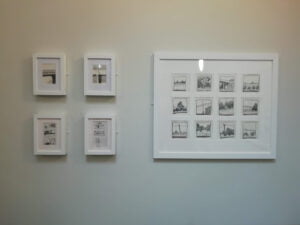
In this brand new column for The State of the Arts, artist-curator Court Spencer interviews creatives based in Leeds and beyond, to learn about their practice and – when permitted – visit them in their studios.
For her first instalment, she speaks to Si Smith, an illustrator and artist who has worked with Court on a number of projects and appeared as part of her Leeds Summer Group Show exhibition last year, featured on The State of the Arts.
Hey Si. Thanks for chatting to me about your recent solo exhibition, Small Drawings at Left Bank Leeds. It was one of very few exhibitions I actually got to see in 2020 so I was very excited to see it in person before it was cut short by the second lockdown.
First of all, can you just tell us a little about your practice: you’re an illustrator, artist, educator, curator and all-round nice guy! Has drawing always been important to you from an early age?
Hi Court, I’m glad that you got to see the show… and that you enjoyed it!
I grew up with art-making in the house – my dad and my grandad both painted landscapes, relying heavily on observational drawing. I guess that they were my role models, so I grew up with the assumption that adults make art. There were always art materials around the place which I was encouraged to use. These days, if I haven’t drawn for a while I’m a bit on edge. If I’m out and don’t have a pencil and notebook with me I’ll be feeling a little anxious. It’s more than just some activity – drawing is the most natural way for me to engage with, process and experience the world around me.
So with what sounds like a pretty consistent drawing practice, do you make any distinction between what you consider to be your illustration and your art?
Probably the most obvious distinction would be that the illustration work is commissioned and the briefs for those jobs are often quite specific. Unlike my art stuff, where I’m just enjoying the freedom of experimenting. Sometimes I’ll get a commission where the brief is wide open, where the job becomes more collaborative than usual, and the lines between the art and the illustration can become enjoyably blurry.
Illustration naturally pushes you to be more proficient. So the art side of my practice has largely grown out of a need to push away from proficiency and into wrestling with new materials, tools and ways of working so that I keep learning.
Within this exhibition you’ve presented three series that you’ve put under the headings of Garden, Journeys and People. Were you making these drawings with this exhibition in mind?
No, none of them were made with an exhibition in mind, they were just made as part of what I guess you’d call my practice. But drawing really is just what I do, and so the work in the show is just the product of that way of being.
How did the exhibition come about?
You’ll have to take a lot of the responsibility for that. You had been encouraging me to show some of my work and I didn’t think that I had a coherent body of work worth showing but I’d put my drawings up on Instagram, and the responses on there made me think that maybe there was something worth exhibiting after all. I’ve got maybe a thousand small drawings here in the studio, and 181 pieces made it up onto the wall in the show. Seen together, they make sense, and are a much better representation of the practice that’s produced them.

Yeah I can see that; the number of drawings presented in this way gives a real glimpse into your appraoch and how embedded drawing is in your daily life. You said the Garden series was a very deliberate way to impose a routine on yourself. How long did you continue that routine?
Most of the garden drawings were made between May and July 2018, and the routine of starting each working day with this kind of contemplative drawing ritual was really brilliant for me. I have that classic introverts’ hyper-focus thing going on, so adopting this daily ritual was like pressing the ‘reset’ button. It gave my day some structure and rhythm again.
You’ve said that the Journey series was made as a passenger in a car or sat on a train, and that these drawings were often made as a way of processing what was going on, be it going to a friend’s funeral or visiting your mum when she was really ill. How do you feel about these images now, do they evoke the same feelings you were experiencing when you made them? And do you want the viewer to understand the context in which they were made?
With some of those drawings, I definitely do get a very strong and specific memory, like déjà vu of the moments when they were made and the stuff that I was processing as I made them. I think it’d be unrealistic of me to expect an audience to fully appreciate the context that the images come out of and for the most part I’ve chosen titles for them which are designed to give very little away – maybe ‘To Ken’s Funeral’ #1 and #2 are the exception to that rule. There’s a melancholic emptiness to some of the Journey images which is quite obvious, especially when you see them hung together as a body of work.
For me, there’s something universal and accessible in those images and they’re addressing those un-lovely liminal spaces between here and there. But I’m also very willing to accept that might be just me pasting my interpretation onto them. On the whole, I think that what a viewer brings to a piece of work is just as valid as the intentions I had in making it.
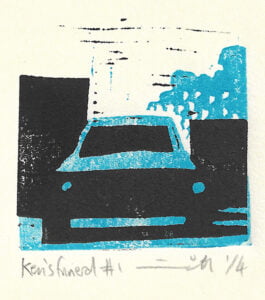
I completely agree. By putting work into a public realm we are inviting viewers to engage with it and they’ll inevitably have different viewpoints and interpretations.
Yes, and it’s always illuminating to hear what folk find in my work which I hadn’t realised was there. The process of making these drawings has been largely about finding better ways to engage with the world. I’ve noticed that the exhibition is an extension of that need for connection – so getting feedback from people has been really important and quite cathartic.
So this need for connection moves us nicely to the third section of your exhibition. The Garden and Journey aspects feel a little more intimate and personal to you, but then we have the series of People. These are drawings that you made whilst on the bus or out and about. Do you know any of the people in the drawings? Do you talk to them at all?
No, the process of making those drawings is quite voyeuristic really. As an introvert, drawing people is a way of interacting without actually having to engage with them, and that works for me. If I was talking to people as I drew them, that would fundamentally change the nature of what I was doing. These drawings are made very quickly, sometimes I’m actually looking at the person for just a few seconds before they’re out of view, and that’s very different from what anyone would be entitled to expect from a portrait of themselves. What I’m really drawing is the people, not a singular person, if that makes sense?
Yeah, it does. Do you think any of the people know you’re drawing them, or do you just look like some really intense guy best avoided on public transport?
Heh! I guess that being the bus weirdo is part of the vibe which lets me draw without being interrupted. When I’m drawing I’m plugged into my iPod too, and I think that sort of indicates that I’m in my own little world and I’m not available for conversation. But if someone ever confronted me, I’d happily offer them the drawing if they wanted it!
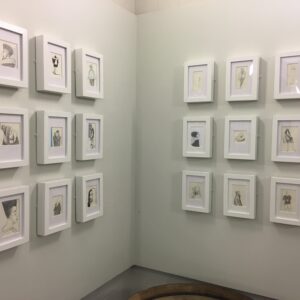
I know you like to work on scrap paper which is why some of the pieces have printed elements in them. Do you find it quite liberating to work on scrap paper or what’s the thinking behind that?
I think that there’s something a bit precious about a lot of art-making, and by working with recycled, repurposed materials I can circumvent that. I made a lot of the People drawings while on public transport, and Leeds’ buses are quite democratic places; one of the drivers for this work and the thing that makes the exhibition cohere is the idea of documenting and celebrating everyone – it’s the idea that this city is not just made of buildings and places, but by the people who occupy those spaces. So, using very basic, non-elitist materials embodies that ideal.
You’ve mentioned that drawing can be a way for you to work through your anxieties. Do you find drawing helps your mental wellbeing?
At a very base level maybe drawing is a coping mechanism for me. When I have struggled with my mental wellbeing, drawing has given me a reason to be properly present in the world. Possibly that’s about me finding a way to exert some sense of control or to order things. And maybe it’s about focus, too.
I guess that it’s something that I’ve not tried to analyse too much; I’m thinking of a line in a Billy Bragg song about taking precious things apart to see how they work, then not being able to put them back together again. I just know that it’s something that functions well for me.
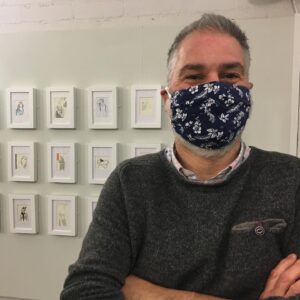
Are there other series of small drawings that you’re working on?
Well, I’m always drawing! But I’ve not been out and about much this year. I’ve found that quite difficult and whilst drawing is very beneficial to my mental wellbeing, it’s also something that I know that I need to work at. Back in September, between lockdowns, we got away for a week in Scotland, and I was fairly prolific there – maybe there’s an exhibition in the drawings that I made up there.
Where can people find out more about your upcoming exhibitions or see your work online?
The best place to keep up with me is probably on Instagram, where you can find me @curmudgeonly_si – I also keep a drawing blog and I try to update that regularly with drawings and things that I’m working on. I currently have some small drawings and a couple of woodcut prints in the ‘Body of Water’ exhibition that just opened at the Sunny Bank Mills gallery in Farsley. Sadly, Covid restrictions mean that the gallery is currently closed to visitors, but you can go see the show online. There’s some good stuff there.
Well Si, it’s been a pleasure as always! Great to find out more about your practice, if lockdown eases, I look forward to seeing the ‘Body of Water’ exhibition at Sunny Bank Mills and I’m really excited to see what you focus on next.
Follow Courtney and Si on Instagram to find out more about what they are getting up to.
Courtney Spencer is an Australian artist, curator and collaborator who has made Leeds her home since 2005. She founded and curates the Leeds Summer Group Show, an annual exhibition that began in 2015; was the Director of the arts venue, Left Bank Leeds for 5 years; is a founding member of the Donut Group (a network of arts organisations working within communities outside Leeds city centre); and has commissioned new works such as INF23 by Michael Shaw and Critical Mass by Eva Mileusnic.
Filed under: Art & Photography
Tagged with: art, column, court Spencer, drawing, exhibition, illustration, interview, leeds, leeds summer group show, Left Bank Leeds, si smith, snooping through studios, Studio, studio visit, Sunny Bank MIlls
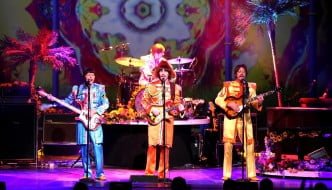
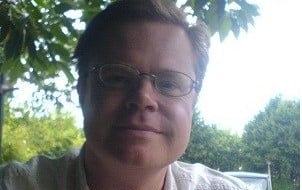
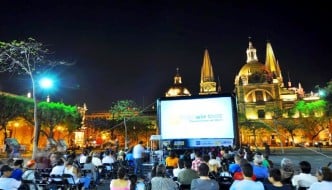
Comments